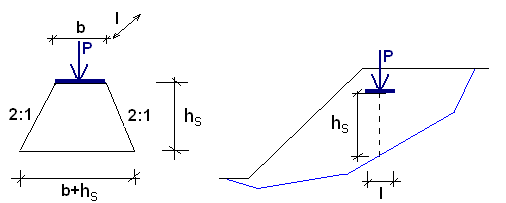Surcharge
The slope stability analysis takes into account even the surcharge caused by neighboring structures. The surcharge can be introduced either as a concentrated force or distributed load acting either on the ground surface or inside the soil body.
Since it is usually assumed that the surcharge is caused by the weight of objects found on the slope body, the vertical component of surcharge having the direction of weight (material component) is added to the weight of blocks. It means that if the earthquake effects are included this component is also multiplied by the factor of horizontal acceleration or vertical earthquake. The material surcharge component also influences the position of block centroid. The components that do not act in the direction of weight are assumed in equations of equilibrium written for a given block as weightless thus neither contributes to inertia effects of the earthquake nor position of block centroid.
The surcharge is always considered in the analysis with respect to one running meter. Providing the surcharge, essentially acting over the area b*l, is introduced as a concentrated force it is transformed before running the analysis into a surface load spread up to a depth of slip surface along the slope 2:1 as displayed in the figure.
 Scheme of spreading the concentrated load on the slip surface
Scheme of spreading the concentrated load on the slip surface
The analysis then proceeds with the resultant of surface load p having the value:
![]()
It is also possible to consider a special type of surcharge - the water above the terrain.